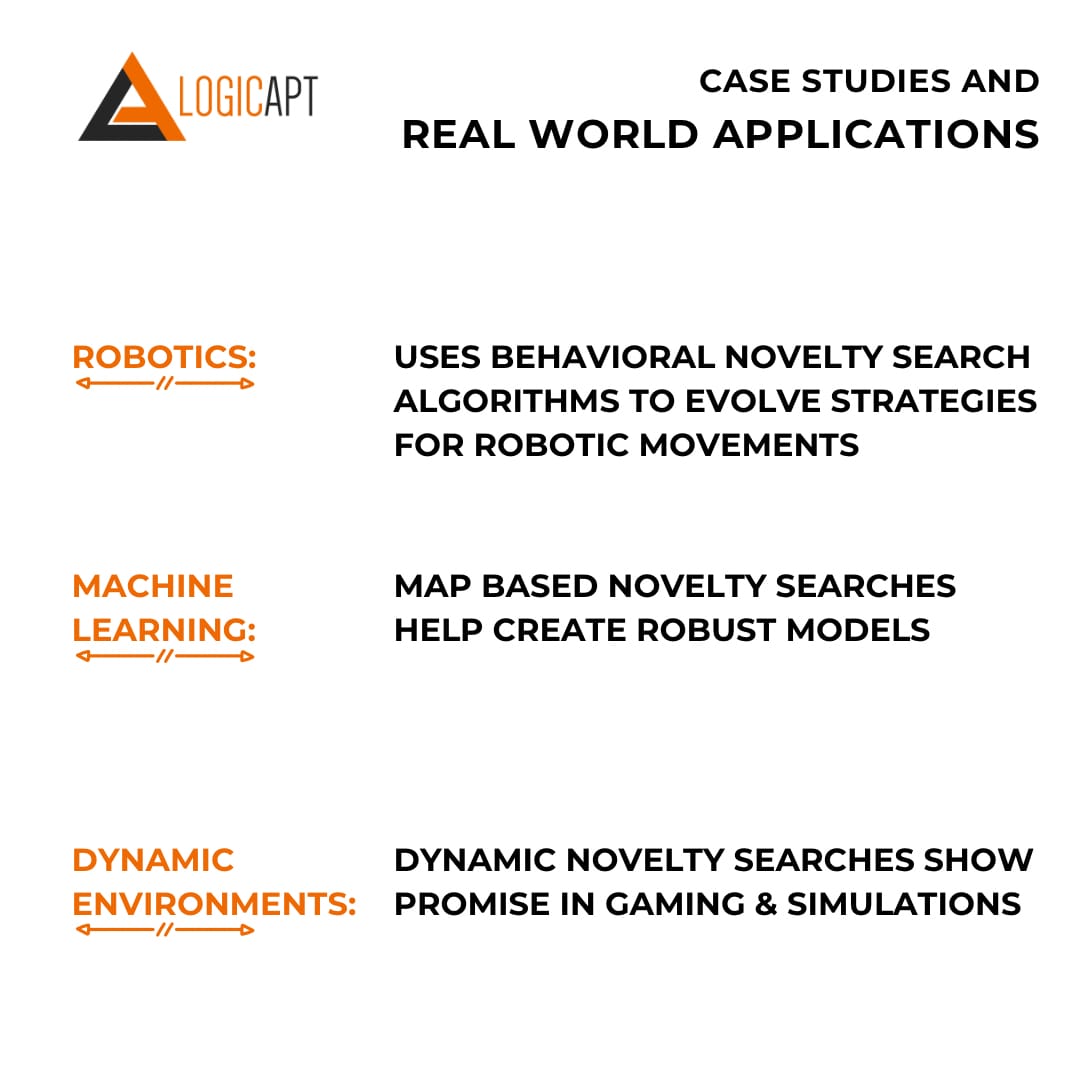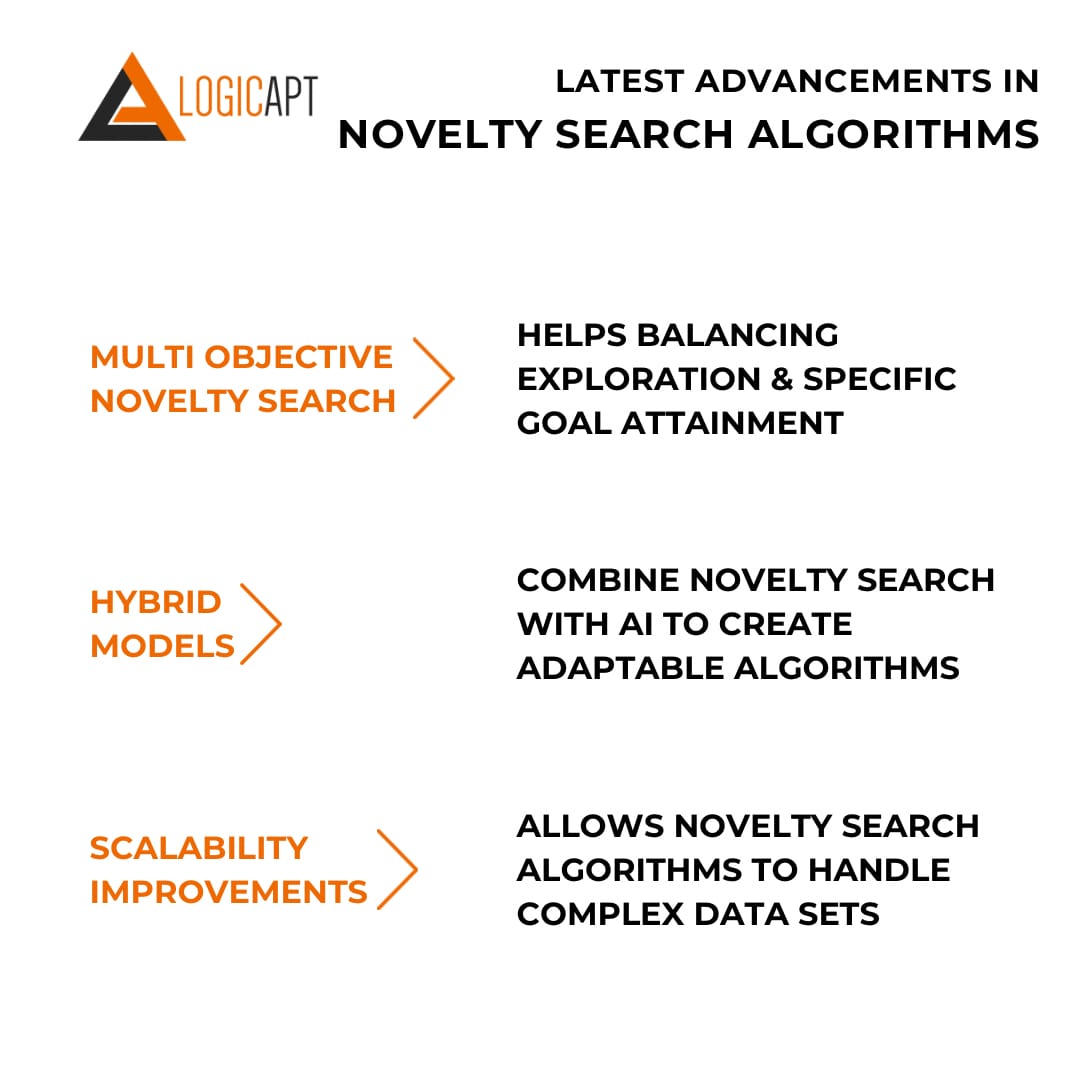Navigating the Complexities of Novelty Search Algorithms in Genetic and Evolutionary Computing

In the ever-evolving domain of computational problem-solving, the emergence of novelty search algorithms marks a significant milestone. These algorithms, distinct from traditional methods, have revolutionized how solutions are discovered and optimized in various fields.
What Are Novelty Search Algorithms?
Let's dive into what exactly constitutes a novelty search algorithm. At its core, a novelty search algorithm is a type of algorithm that prioritizes the discovery of unique and unexplored solutions over the optimization of known solutions. Unlike traditional algorithms that focus on optimizing towards a predefined goal, novelty search algorithms explore the solution space without a fixed objective, aiming to uncover diverse and innovative solutions.
The Evolution of Novelty Search Algorithms
How did these algorithms evolve? The concept of novelty search emerged from the realization that, while efficient, conventional optimization algorithms often miss out on potentially groundbreaking solutions by focusing too narrowly on specific objectives. Novelty search algorithms, in contrast, broaden the search scope, facilitating the exploration of a more diverse set of possibilities. This approach is particularly beneficial in complex environments where the landscape of potential solutions is vast and poorly understood.
Importance in Computational Problem Solving
The importance of novelty search algorithms in computational problem-solving cannot be overstated. They offer a paradigm shift in approaching complex problems, especially in fields like artificial intelligence, robotics, and machine learning. By prioritizing exploration over exploitation, these algorithms can discover solutions that conventional methods might overlook. This exploratory approach is crucial in tasks where the goal is not well-defined, or the landscape of potential solutions is highly complex and multi-dimensional.
The interplay between novelty search and evolutionary algorithms is particularly noteworthy. Evolutionary algorithms, known for simulating the process of natural evolution to solve optimization problems, find a complementary partner in novelty search algorithms. Combining evolutionary techniques with the exploratory nature of novelty search can lead to more robust, adaptive, and innovative solutions in various computational challenges.
The Concept of Novelty Search in Genetic Algorithms
Overview of Genetic Algorithms
Genetic algorithms (GAs) are a cornerstone of evolutionary computing. Rooted in natural selection and genetics principles, these algorithms are used to solve optimization and search problems. GAs generate a population of potential solutions that evolve over successive generations. Evolution involves processes akin to biological evolution, including selection, crossover, and mutation. The goal is typically to find the best solution or set of solutions to a given problem.
Integration of Novelty Search Within Genetic Algorithms
When novelty search is integrated into genetic algorithms, the focus shifts from searching for the optimal solution to exploring diverse solutions. Unlike traditional GAs, which use a fitness function to guide the evolution toward a specific goal, novelty search algorithms in GAs prioritize the uniqueness and diversity of solutions. This integration leads to a more exploratory approach, where the algorithm seeks out new and untested solutions, irrespective of their initial perceived performance.
Benefits of Integrating Novelty Search in GAs

- Enhanced Exploration: Novelty search expands the search space, allowing GAs to explore solutions that traditional fitness-based approaches might overlook.
- Avoiding Local Optima: In complex problem spaces, GAs can get stuck in local optima. Novelty search helps in navigating away from these local optima, potentially leading to globally optimal solutions.
- Diverse Solution Sets: By emphasizing novelty, these algorithms can generate a broader range of potential solutions, increasing the chances of finding innovative and practical answers to complex problems.
Challenges in the Integration
But here’s the kicker: Integrating novelty search with genetic algorithms is challenging.
- Balance Between Exploration and Exploitation: Finding the right balance between exploring new solutions and refining the best ones is critical and challenging.
- Defining Novelty: Determining what constitutes a 'novel' solution can be subjective and depends significantly on the problem domain.
- Computational Resources: The exploratory nature of novelty search can require more computational resources, as it involves evaluating a more extensive set of potential solutions.
Exploring Novelty Search Algorithms
Detailed Exploration of Various Novelty Search Algorithms
Novelty search algorithms are diverse, each with unique features and approaches to exploring solution spaces. Some notable algorithms include:
- Behavioral Novelty Search: Focuses on the behavior of solutions rather than their fitness, encouraging the exploration of diverse behavioral traits.
- Map-based Novelty Search: Utilizes a map of the solution space to track and encourage exploration in underrepresented areas.
- Dynamic Novelty Search: Adapts its approach to novelty as the search progresses, often used in dynamic environments where conditions change over time.
Case Studies and Real-world Applications

Let's examine how these algorithms are applied in real-world scenarios:
- Robotics: Behavioral novelty search algorithms have been used to evolve novel strategies for robotic movement, leading to more adaptable and efficient robots.
- Machine Learning: In machine learning, map-based novelty searches help create diverse training sets, leading to more robust models.
- Dynamic Environments: Dynamic novelty searches have shown promise in gaming and simulations, where conditions change rapidly and unpredictably.
Comparative Analysis
What’s the bottom line? While each novelty search algorithm has its strengths, they also have limitations. For instance, behavioral novelty searches can generate various solutions but might struggle to pinpoint the most efficient ones. Map-based novelty searches provide a comprehensive view of the solution space but can be computationally intensive. Dynamic novelty searches excel in changing environments but require sophisticated adaptation mechanisms.
Evolutionary Algorithms and the Role of Novelty Search
Deep Dive into Evolutionary Algorithms
Evolutionary algorithms are a fascinating aspect of artificial intelligence inspired by biological evolution. These algorithms iteratively evolve solutions to a given problem, guided by selection, mutation, and crossover mechanisms. Commonly used evolutionary algorithms include Genetic Algorithms (GAs), Genetic Programming, and Evolution Strategies. Each method mimics natural evolutionary processes to optimize problem-solving in a computational setting.
The Synergy Between Novelty Search and Evolutionary Algorithms
The integration of novelty search into evolutionary algorithms creates a potent synergy. This combination leverages the robust optimization capabilities of evolutionary algorithms with the exploratory and innovative approach of novelty search. In this hybrid model, the algorithm does not just evolve toward the fittest solution but is encouraged to explore the solution's novel and potentially uncharted areas. This synergy enhances the algorithm’s ability to avoid local optima and discover more creative, diverse solutions.
Case Examples Demonstrating This Integration
- Optimizing Neural Networks: In the field of neural network design, combining novelty search with evolutionary algorithms has led to the development of more adaptive and efficient network architectures.
- Autonomous Vehicle Navigation: The application of this integration in autonomous vehicle navigation has resulted in more innovative pathfinding algorithms capable of handling unexpected obstacles and scenarios.
- Biological Modeling: This synergy has created more accurate and diverse models in biological modeling, reflecting a broader spectrum of biological phenomena.
Advanced Techniques and Innovations in Novelty Search Algorithms
Latest Advancements in Novelty Search Algorithms

The field of novelty search algorithms is rapidly advancing, with new developments continually emerging. These advancements are focused on enhancing these algorithms' efficiency, scalability, and applicability. Recent innovations include:
- Multi-Objective Novelty Search: Integrating multiple objectives into the novelty search process to balance exploration and specific goal attainment.
- Hybrid Models: Combining novelty search with AI techniques like reinforcement learning and deep learning to create more powerful and adaptable algorithms.
- Scalability Improvements: Enhance the scalability of novelty search algorithms, allowing them to handle more extensive and complex datasets.
Innovations in Genetic and Evolutionary Algorithms
The world of genetic and evolutionary algorithms needs to catch up in innovation. Recent advancements include:
- Adaptive Genetic Algorithms: These algorithms can adjust their parameters (like mutation rate) in real-time, improving their efficiency and effectiveness.
- Co-Evolutionary Algorithms: Involving multiple evolving populations that interact with each other, these algorithms mimic more complex evolutionary processes.
- Quantum Evolutionary Algorithms: Integrating principles of quantum computing to enhance the capabilities of evolutionary algorithms.
Future Trends and Predictions
Looking ahead, novelty search and evolutionary algorithms are poised for exciting developments. Future trends include:
- Increased Integration with Machine Learning: We can expect deeper integration of novelty search algorithms with machine learning models, leading to more sophisticated AI systems.
- Application in Unconventional Fields: Novelty search algorithms will likely find applications in emerging fields like quantum computing and bioinformatics.
- Focus on Real-World Problem Solving: A shift from theoretical models to practical applications in real-world scenarios is anticipated, with these algorithms solving complex, dynamic problems.
Practical Applications and Impact of Novelty Search Algorithms
Practical Applications in Various Industries
Novelty search algorithms have found many practical applications across different industries, demonstrating their versatility and effectiveness. Some notable applications include:
- Automotive Industry: Utilized in developing autonomous driving systems, novelty search algorithms help create more adaptive and safe navigation strategies.
- Healthcare: In drug discovery and genetic research, these algorithms aid in identifying novel compounds and genetic markers, accelerating the pace of medical breakthroughs.
- Financial Sector: Applied in algorithmic trading, novelty search algorithms contribute to developing innovative trading strategies that adapt to volatile market conditions.
Impact on AI, Machine Learning, and Other Fields
The influence of novelty search algorithms extends beyond specific industries to more fundamental areas like artificial intelligence and machine learning. Here's how:
- Enhanced AI Creativity: Novelty search algorithms foster creativity in AI systems, enabling them to generate more diverse and innovative solutions.
- Robustness in Machine Learning Models: By exploring a broader range of data and scenarios, these algorithms contribute to developing more robust and generalizable machine learning models.
- Advancements in Robotics: Novelty search algorithms are instrumental in developing robots capable of adaptive and unexpected behaviors, enhancing their utility in dynamic environments.
Challenges and Solutions in Implementing Novelty Search Algorithms
Addressing Common Challenges in Implementing Novelty Search Algorithms
Implementing novelty search algorithms has challenges that must be navigated carefully for effective application. These challenges include:
- Defining and Measuring Novelty: One of the primary challenges is defining what constitutes novelty in a given context and developing reliable metrics to measure it.
- Balancing Exploration and Exploitation: Achieving the right balance between exploring new possibilities and exploiting known good solutions is tricky in implementing novelty search algorithms.
- Handling Computational Complexity: Novelty search algorithms' inherent complexity and computational demands can be a significant hurdle, especially in large-scale applications.
Proposed Solutions and Best Practices
To overcome these challenges, several solutions and best practices can be adopted:
- Developing Adaptive Metrics: Creating adaptive metrics that can evolve with the problem context is crucial for effectively measuring novelty.
- Multi-Objective Approaches: Implementing multi-objective algorithms considering novelty and traditional performance metrics can help balance exploration and exploitation.
- Optimizing Algorithm Efficiency: Enhancing the efficiency of algorithms through techniques like parallel processing and cloud computing can mitigate computational challenges.
Conclusion: The Future of Novelty Search in Genetic and Evolutionary Computing
Recap of Key Insights
Throughout this piece, we've delved into the intricate world of novelty search algorithms and their integration with genetic and evolutionary algorithms. Key insights include:
- Innovative Approach: Novelty search algorithms represent a paradigm shift in computational problem-solving, focusing on exploring uncharted solution spaces.
- Synergy with Evolutionary Algorithms: Integrating novelty search with evolutionary algorithms has resulted in more robust and creative problem-solving methods.
- Diverse Applications: These algorithms have found applications across various industries, from robotics to healthcare, demonstrating their versatility.
The Potential Future Trajectory of Novelty Search Algorithms
The future of novelty search in genetic and evolutionary computing appears promising and is poised for further innovations. We can anticipate:
- Greater Integration with AI and Machine Learning: As AI and machine learning continue to evolve, the role of novelty search algorithms in these fields is likely to become more prominent and influential.
- Expansion into New Domains: Novelty search algorithms are expected to penetrate emerging fields, offering unique solutions to complex and dynamic problems.
- Continuous Advancements: Ongoing research and development will likely lead to more sophisticated and efficient novelty search algorithms, further enhancing their applicability and effectiveness.
Final Thoughts
The journey of novelty search algorithms is a testament to the ever-evolving nature of computational problem-solving. The continued exploration and innovation in this field promise more advanced algorithms and a deeper understanding of the complex problems they are designed to solve.

Additional Resources and References
- "Approximate Novelty Search": Ar5iv.org - this paper discusses the accuracy and performance of approximate novelty search, providing insights into its effectiveness and challenges in different computational contexts.
- Additional Papers: Numerous studies are available on platforms like ResearchGate, IEEE Xplore, and Google Scholar. These platforms offer a wealth of information on novelty search algorithms, including various applications, advancements, and theoretical underpinnings.
For a more comprehensive list of resources, visiting academic databases like ResearchGate, IEEE Xplore, and Google Scholar, where you can search for papers specifically tailored to your interests in novelty search algorithms, is recommended.

